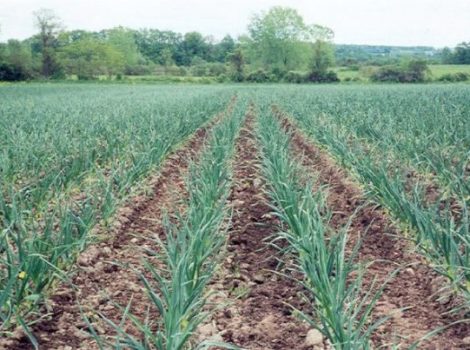Content
- 1 Should I plant cucumbers and tomatoes together?
- 2 Conditions for growing crops
- 3 The best varieties for co-cultivation
- 4 Combination conditions
- 5 Soil preparation and top dressing
- 6 Caring for shared cultures
- 7 Conclusion
- 8 Vegetable compatibility
- 9 Compatibility criteria
- 10 Mixed landings
- 11 Mixed planting basic principles
- 12 Technology for growing vegetables in a greenhouse
- 13 Year-round greenhouse cultivation
- 14 Tomato vegetable compatibility
- 15 Peppers and other vegetables
- 16 What is the best way to plant eggplants in a greenhouse
- 17 Neighborhood with cucumbers
- 18 Cucumbers in the greenhouse
- 19 Joint planting of cucumbers in a greenhouse or polycarbonate greenhouse
- 20 Advantages
- 21 What to plant and grow with cucumbers
- 22 Unwanted neighbors for cucumbers
- 23 Feasibility of joint landing
- 24 Selection of varieties for combined plantings
- 25 How to plant correctly?
Of course, ideally, each crop should be under a separate defensive structure. But what to do if it is difficult? How can these different cultures be reconciled?
Should I plant cucumbers and tomatoes together?
Experienced gardeners believe that growing cucumbers and tomatoes in the same greenhouse is not the best option to reap a large harvest.
The point is that tomatoes and cucumbers are completely different crops with distinctive needs. The differences lie in the need for lighting, the level of humidity.
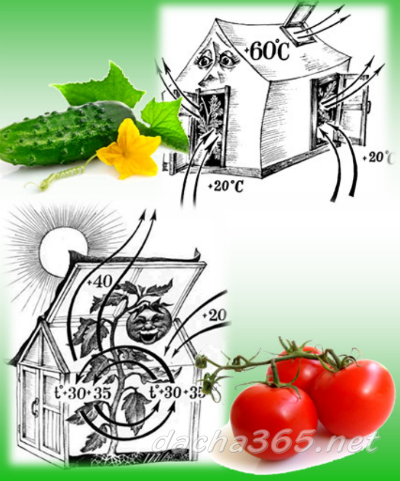
Planting cucumbers and tomatoes together can lead to a problematic situation. Summer residents strive to meet the needs of each crop, but this leads to a decrease in yield. By increasing the level of humidity in the greenhouse, the growth of tomatoes slows down and their immunity decreases, the risk of tomato damage by late blight increases. The pollen of the seedlings becomes wet, the inflorescences cease to be pollinated. As a result, new ovaries do not appear on the plants.
If, on the contrary, you create comfortable conditions for the tomato, then this will reduce the yield of cucumbers. Decreased air humidity, irregular watering, ventilation of the greenhouse can slow down the growth of lashes. Under such unfavorable conditions, the plant may die.
Comfortable conditions:
- Tomatoes: low air humidity, occasional watering, frequent ventilation and drafts, application of fertilizers containing phosphorus and potassium.
- Cucumbers: air humidity above 85%, frequent watering, air temperature not less than + 22 degrees, application of fertilizers with nitrogen content.
How to find a middle ground if there is no opportunity to grow two different crops of vegetables separately? Tomatoes and cucumbers can still grow together in the same greenhouse. However, for this, several conditions must be met.
It is important to understand! It is necessary to take into account the characteristics of each culture. What atmosphere in the greenhouse is optimal for the growth of both tomatoes and cucumbers.
Conditions for growing crops
Cucumber growing technique
In a polycarbonate greenhouse:
- Fill in drainage from stones and expanded clay. Drainage is necessary so that excess water does not linger.
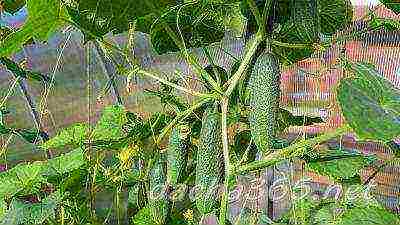
- To create soil in the greenhouse, you need to use peat and sawdust in a ratio of 10: 2. Next, 20 g of superphosphate and 10 g of potassium sulfate and nitrate are added to 10 kg of the mixture.
- After two weeks, this mixture must be moistened with water. Then the seeds are soaked in it for about 12 hours.
- The seeds should be planted in furrows about 1 cm deep.In winter, the seeds do not require germination. The first shoots, under favorable conditions, will appear after a short period of time.
- In a polycarbonate greenhouse, you need to observe the watering regime. It is worth abandoning private irrigation of the beds. If such nuances are observed, the plants will have inflorescences, and, therefore, it is worth waiting for a good harvest.
- After the fruits appear, watering must be increased.
Tomato growing technique
For tomatoes, it is necessary to create completely opposite conditions. The lack of a ventilation system and high humidity will lead to late blight. A brown spot, gray rot appears on the plants. Such diseases are dangerous for seedlings.
Tomatoes are rarely watered, as they do not tolerate high humidity. The ideal frequency of soil moistening is once a week. It is important to follow the correct watering technique. The water should fall under the root, and not on the leaves and stems of the plant. This is necessary so that evaporation does not occur, and the water goes directly into the ground.
Tomatoes do not tolerate heat. If the air temperature exceeds +25 degrees, then the fruits stop developing and ripening. It is for this reason that the greenhouse needs to be opened during the day, or an artificial draft must be created using the vents.
Tomatoes do not require nitrogen-based fertilizers. On the contrary, it is worth giving preference to fertilizers that contain phosphorus and potassium.
Watch the video! How to grow cucumbers and tomatoes in the same greenhouse
The best varieties for co-cultivation
In order to jointly grow cucumbers and tomatoes in a greenhouse, it is necessary to correctly approach the choice of seed.
It is worth paying attention to such varieties of tomatoes that are resistant to high levels of humidity and phytophthora:
- "Dwarf";
- "New Year";
- "Dubok";
- "Lyubasha";
- Soyuz 8;
- "Lark";
- "Dubrava";
- "Blizzard".
These varieties are hybrids and specially bred by experienced agronomists. The varieties of tomatoes presented above have strong immunity and steadily tolerate diseases that tomatoes are susceptible to if there is high humidity in the greenhouse. Of course, the choice of such a hybrid crop variety does not completely minimize the occurrence of problems with joint cultivation. It should be understood that choosing only a special variety of tomatoes to get a good harvest is not enough, it is important to observe other conditions.
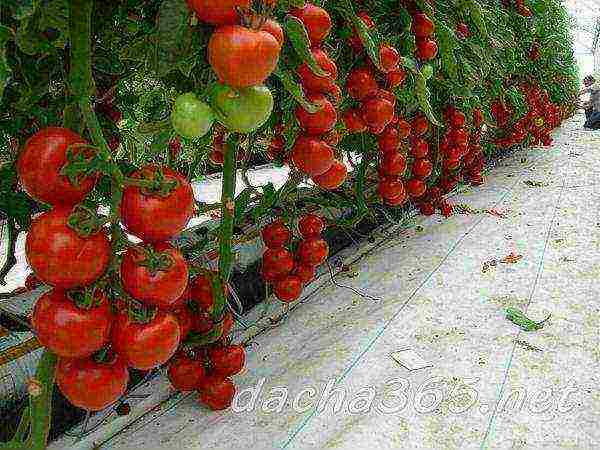
The choice of cold-resistant cucumber varieties should also be taken responsibly. If the temperature in the greenhouse does not correspond to the declared standards, then this leads to an increased risk of developing diseases in cucumbers. The most famous diseases among such a capricious culture are considered to be: powdery mildew, anthracosis and bacteriosis.
Important! Diseases to which cucumbers are susceptible can be transmitted to tomato crops. And this in turn can lead to the loss of crops like cucumbers and tomatoes.
Well-known agronomists have been able to develop many varieties of cucumbers that are resistant to diseases and are suitable for growing in open ground:
- "Masha";
- "Benefit";
- "Herman F1";
- "Thumb Boy";
- "Sister Alyonushka".
- "Goosebump";
- "Crane";
- "Natalie".
Choosing one of the varieties presented above that are resistant to cold and diseases, you can not worry about creating special specific microclimate conditions. Such hybrid varieties tolerate airing and drafts, which are important for pollination of tomatoes.
Combination conditions
Professionals identify special conditions for a favorable neighborhood of tomatoes and cucumbers:
- Cucumber whips should not shade tomatoes;
- The ideal place for growing tomatoes is considered at the entrance to the greenhouse. It is there that ventilation is much more intense, which in turn reduces the level of humidity and the risk of diseases is less;
- It is worth paying attention to varieties that are resistant to late blight;
- It is important not to forget about additional pollination.To do this, you need to shake the flowering plants slightly;
- The cucumbers should be planted at the end of the greenhouse. It is there that there are no drafts that lead to a decrease in humidity.
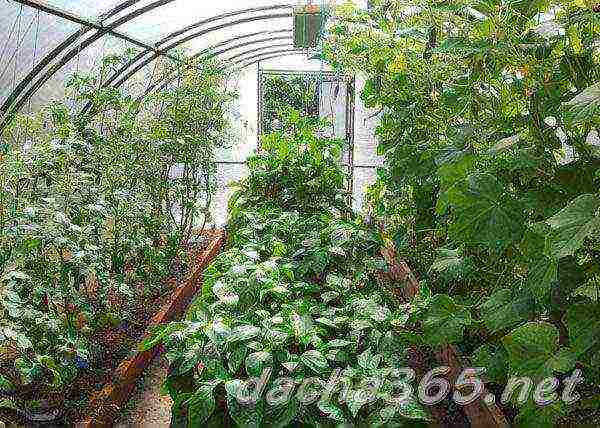
Option number 1 - Separation by film
It is worth starting by separating the beds from each other using film. The film must be stretched from the ground to the roof of the greenhouse. This method will help create a specific microclimate for each crop. The only condition is that it is necessary to take into account that a ventilation system is provided in that part of the greenhouse where the tomatoes grow. The entrance to the greenhouse zones should be separate from each end. In addition to the air fencing, the soil must also be shielded. It is important to leave a distance between the cucumber and tomato beds. If it suddenly turns out that the beds of tomatoes and cucumbers are too close, then you should use a metal sheet for the fence. This will allow, with abundant watering of cucumbers, not to create unfavorable conditions for tomatoes.
Option number 2 - Separate landing
There is an option without the use of film. To use this method, it is necessary to correctly distinguish between the beds with cucumbers, peppers and tomatoes.
The ideal option would be a competent division of the territory:

- Peppers should highlight the southern side of the greenhouse. This is due to the fact that such a culture is thermophilic;
- Tomato bushes will grow favorably in the center of the greenhouse, since this part is well ventilated. In addition, places near doors, windows may be suitable;
- Cucumbers should be planted from the north, as moisture from the plant evaporates much more slowly. Draft-protected corners of the greenhouse are not bad for growing cucumbers.
Soil preparation and top dressing
Humus, peat, sawdust, sand must be enriched with a teaspoon of sodium nitrate or urea, and 1 tablespoon each of potassium and magnesia sulfate, add 3 tablespoons of double superphosphate and 500 grams of wood ash. Next, fertilizing is scattered over the selected area and the soil is dug up.
Advice! Cucumbers should be fed every decade with nitrate in a proportion of 20 grams per bucket of water.
Tomatoes also need feeding every ten days:
- Option 1: dissolve 0.5 liters of liquid mullein + a tablespoon of nitrophoska in 10 liters of water. Each bush needs about 1 liter of solution;
- Option 2: dissolve a teaspoon of potassium sulfate in 10 liters of water, as well as a tablespoon of complete fertilizer (fertilize in a ratio of 5 liters per square meter);
- Option 3: in 10 liters of water you need to dissolve a couple of tablespoons of wood ash and a tablespoon of superphosphate (fertilize in a ratio of 6 liters per square meter).
Plants on which tomatoes have already formed must be fertilized with a solution of two tablespoons of superphosphate and one spoon of liquid sodium humate (5 l / sq. M). This type of fertilization will speed up the ripening of fruits.
Caring for shared cultures
Cucumber care
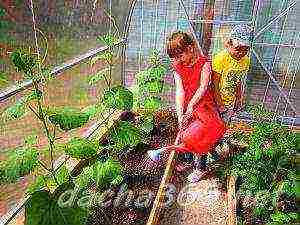 Cucumbers are moisture-loving plants that require abundant and frequent irrigation with warm water. Standing water is ideal for irrigation. The use of a leaf sprayer is recommended. The optimum humidity in the greenhouse is -85%. Subject to these rules, the yield of cucumbers will be high.
Cucumbers are moisture-loving plants that require abundant and frequent irrigation with warm water. Standing water is ideal for irrigation. The use of a leaf sprayer is recommended. The optimum humidity in the greenhouse is -85%. Subject to these rules, the yield of cucumbers will be high.
For even plant growth and the appearance of ovaries, the temperature should be at least 22 and not exceed 28 degrees. Cucumbers do not tolerate airing and natural drafts. Do not forget about regular feeding of seedlings.
Until the fruit of cucumbers appeared, water the seedlings often, but not abundantly. As a result, female flowers will form, which will allow for a good harvest. After the fruits have appeared, it is necessary to increase watering.
Tomato care
You need to grow tomatoes in polycarbonate structures.
- The correct bed should be 90 cm wide and 40 cm high. It is ideal to leave the passage between the seedlings about 60 cm.The passage between the bushes must be essential for comfortable growth and ripening of fruits.
- Seedlings, the height of which does not exceed 30 cm, should be placed vertically in the ground.
- Add soil to the hole should be added two weeks after the seedlings take root.
- The first two weeks should refrain from abundant watering.
- After the stem is pulled out, it must be tied to the trellis. The most optimal is the ovary of seven brushes with inflorescences. The resulting extra stepsons need to be cut off.
Watch the video! How to water tomatoes and cucumbers in a greenhouse
Hydrogel - water substitute
Hydrogel is a salvation for many lovers of joint cultivation of tomatoes and cucumbers. This type of adsorbent ideally solves the problem of waterlogging of air and soil. Hydrogel crystals almost instantly absorb excess water during irrigation. And they pass it on to the roots of moisture-loving seedlings.
Since the hydrogel absorbs water, during watering, intensive evaporation of moisture does not occur into the air, and, therefore, the humidity in the greenhouse does not increase. The adsorbent does not lead to a decrease in the level of immunity in tomatoes, but on the contrary enriches the cucumbers with liquid. Thus, it is comfortable for two crops to grow side by side at the same time.
How to mark out a hydrogel? During planting of cucumber seedlings, 0.5 cups of hydrogel is introduced into the hole, then it is watered abundantly and the plant must be dug in.
The hydrogel is ideal not only for absorbing water, but also mineral fertilizers dissolved in them. If the granules are soaked before the first use in a fertilizer solution, then you can not worry about plant nutrition for a long time.
Moisture retention mulch
If it so happens that the cucumbers are already planted in the greenhouse without a hydrogel, then mulching is recommended. This will help to retain moisture at the roots of the plant and the evaporation process will be reduced.
Mulch usage rules:

- Prepare cut grass or weeds.
- After the cucumber shoots appear, cover the soil around the shoots with a layer of mulch (about 10 centimeters).
- Continuously add a layer of mulch as it subsides.
Mulching will reduce the amount of watering. In addition, the layer of mulch gives off the heat that cucumbers love so much. Evaporation of moisture will occur under the mulch. The bottom layer of mulch, during gradual decomposition, releases heat and nutritious organic fertilizers, which are necessary for the growth of vegetable crops.
Conclusion
Cucumbers and tomatoes require completely opposite conditions for the growth and ripening of fruits. Cultivation of these two crops together is difficult, but possible. The main rule is to follow the planting scheme and create conditions for the comfortable development of plants. There are many photos and videos on the Internet that allow you to understand in more detail the technology of growing tomatoes and cucumbers in one greenhouse.
Watch the video! Tomatoes and cucumbers in one greenhouse
For novice gardeners, one of the exciting questions is the following: "What to plant with what in a greenhouse?" And what's wrong with that? For those who have not yet encountered gardening work, this question seems silly. In fact, this is not the case: like flowers in a bouquet, vegetables can "be friends" or "not be friends" with each other, so if you want to have a rich harvest, you need to take into account their compatibility.
Vegetable compatibility
Before planting, you should identify compatible and incompatible vegetables. Why this is done: crops that can grow peacefully nearby will be more resistant to various diseases and pests, which increases yields. Conversely, if there are warring plants in the neighborhood, then the harvest will be small.
How does the amount of the crop depend on the plants themselves? The fact is that they emit special substances that penetrate the soil and air, therefore, the nearby garden culture absorbs them and can get harm or benefit. Therefore, with proper planting, there will be a rich, nutrient-rich environment, which will allow the use of less fertilizers.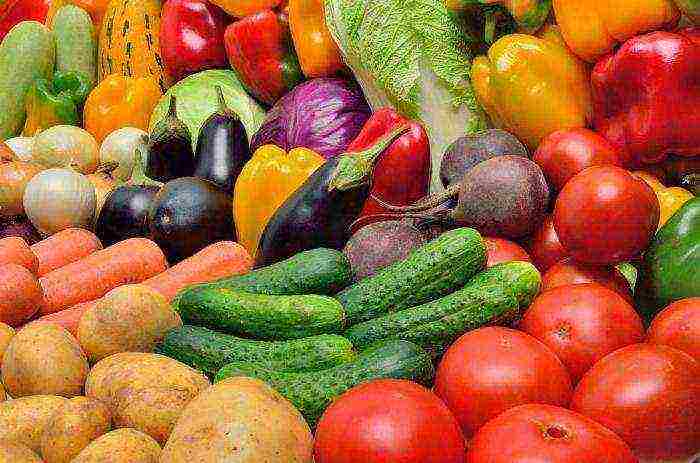
Compatibility criteria
To know what to plant with what in the greenhouse, you need to follow the main criteria by which it is taken into account how effective the vegetable community will be:
- Plant height.The proximity of low and tall crops should not be allowed.
- The same need for air humidity. Some require a hot environment, while others need good ventilation.
- The need for lighting. Plants that need a lot of light should be allocated a spot in the southern part of the greenhouse.
- Some types of crops are excellent precursors for subsequent seedlings. It is very important to observe crop rotation, especially for mixed plantings.
Crop rotation is the alternation of different vegetable crops. Planting the same species in the same location can cause soil depletion. It is recommended to alternate the beds every three years.
Mixed landings
Most gardeners solve the “what to plant with what in the greenhouse” dilemma with a simple method - mixed plantings. They are believed to help increase yields and stimulate crop growth. In addition, such a neighborhood greatly simplifies the greenhouse life: you can save on fertilizers and protection from pests. The point is that some vegetables enrich the soil with useful elements that are necessary for other crops, while others release substances that protect against pests.
But this method also has disadvantages - it is cross-pollination and thickening of vegetables. Pollination can negatively affect the taste of products, and sometimes it also happens that neighboring crops can become infected with pests. Therefore, if a gardener uses a mixed planting, he must monitor the future harvest even more carefully. And in order for the described method to bring good results, you need to remember what to plant with in the greenhouse.
It is best to choose one base vegetable, most often a cucumber or tomato. And already other crops are matched to this basic product.
Mixed planting basic principles
For this method to be effective, you need to know some rules:
- The width of the beds should not exceed 1 m - so it will be more convenient to sow, process.
- Before sowing, you need to mentally divide the garden into several parts. Sowing begins from the central part, in which crops with long growth and the same ripening period are planted. These include cabbage, tomatoes, peppers. By the time of harvest, they will occupy most of the greenhouse.
- Plants with a short ripening period should be planted along the edges of the garden - these are all types of greenery.
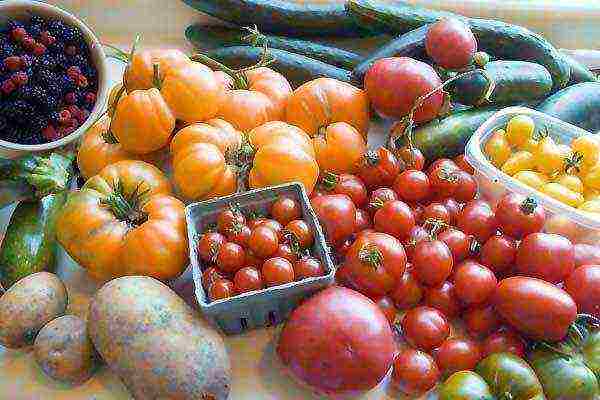
Technology for growing vegetables in a greenhouse
In addition to planting vegetable crops, taking into account their compatibility, you need to know how to grow them correctly. Even if you took into account the neighborhood, you can ruin everything if you do not create the necessary greenhouse conditions. What is a greenhouse for? And it is needed in order to create the necessary microclimate for the growth of vegetables.
In fact, a greenhouse is a miniature tropics, but do not forget about one important nuance: the temperature should not be too high or too low. Therefore, in very hot weather, it is imperative to do airing. Watering greenhouse plants should be more abundant than those that grow in the garden, because there is strong evaporation in the greenhouse.
With a mixed planting, you do not need to plant all crops at the same time - it would be more correct to gradually plant, taking into account the ripening time of vegetables.
Year-round greenhouse cultivation
I would like fresh vegetables to be on the table always, and not only in warm seasons. It turns out that cultivation in a greenhouse is possible all year round. For this, a greenhouse made of polycarbonate is best suited, because it has a fairly high strength, low thermal conductivity and good light transmission.
But in order to create summer conditions during cold seasons, you need to take care of additional lighting, insulation and ventilation in advance.To improve the quality of year-round plantings, it is worth growing ornamental plants next to them, which will help saturate the soil and air with nutrients.
You also need to take care of additional "warming" of the soil with humus, straw. It should only be remembered that a large amount of humus can cause the appearance of various pests, therefore it is necessary to periodically deal with them. Not all vegetable crops are suitable for year-round planting. Preference should be given to the following types:
- Chinese cabbage;
- radish;
- cucumbers;
- tomatoes;
- Bell pepper.
In pursuit of more crops, some gardeners use a variety of chemicals to accelerate growth and maturation. But as a result, vegetables are tasteless and watery. Therefore, it is better not to stimulate the processes with chemical additives, but to take better care of the plants.
Having considered the basic rules for planting in a greenhouse, it is worth returning to the question of what to plant with what in a greenhouse. The following vegetables will be considered: cucumbers, tomatoes, eggplants, peppers.

Compatibility of tomatoes with vegetables
Tomatoes are quite capricious vegetables, so you need to carefully choose the plants that are adjacent to them. Often, gardeners plant cucumbers and tomatoes together, but this is wrong. At first glance, it seems that they are ideal neighbors, but this is a misconception. Although they are similar in their requirements for growing conditions, tomatoes and cucumbers do not get along well together.
Tomatoes need moderate warmth and frequent ventilation because they don't like too much moisture. They should be watered only at the root. Choose places for planting them next to doors or vents.
With what to plant tomatoes in a greenhouse? Eggplants and peppers should be grown with tomatoes because they also need a lot of fresh air. They also grow well next to onions, parsley, herbs, carrots and radishes. But cabbage, pumpkin and strawberries will not get along with tomatoes.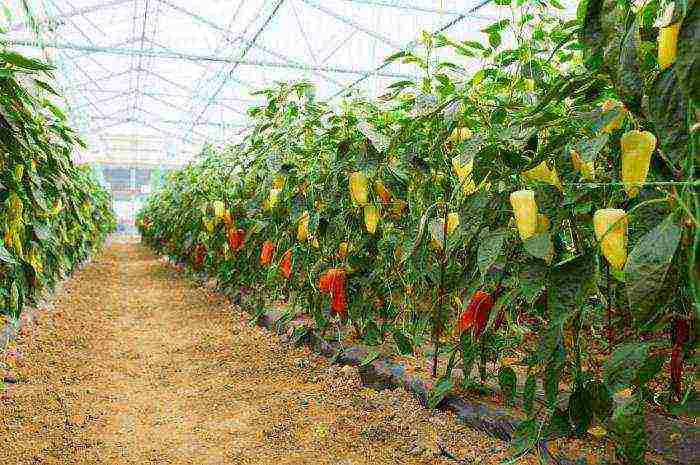
Peppers and other vegetables
Close relatives of pepper are tomatoes, eggplants, potatoes. Consequently, with these agricultural crops, he can easily share one territory. Although, due to their similarity, they can attract the same pests. Some gardeners believe that there can be competition for nutrients and light between related species, resulting in poor harvests.
What is the best way to plant peppers in a greenhouse:
- beans and legumes;
- onion;
- eggplant;
- carrot;
- spices;
- tomatoes.
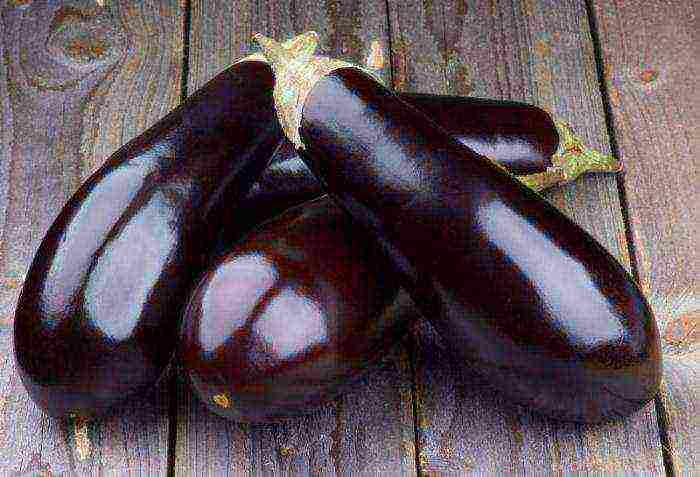
What is the best way to plant eggplants in a greenhouse
Eggplants are quite demanding vegetables, and although they can get along with peppers, it is highly undesirable to plant any other crops next to them, because they really do not like to share space with other vegetables.
But if there is not much space in the greenhouse, and you want to grow purple vegetables, then beans will become a good neighbor for them. Eggplants also grow well next to bell peppers, potatoes. You just need to be careful: if the Colorado potato beetle appears on the potato, you will have to help the eggplants. Therefore, they still should not be planted together.
Good neighbors will be:
- onion;
- carrot;
- cabbage.
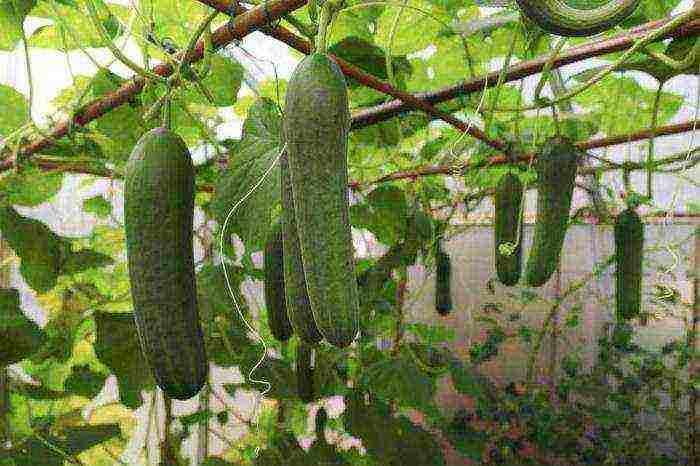
Neighborhood with cucumbers
Cucumbers love heat, high humidity, so you shouldn't often ventilate the greenhouse. During watering, you need to irrigate not only the roots, but also the tops. Use warm water for irrigation. Another feature of these vegetables is that they do not need fertilization, only those containing nitrogen will be enough. The warmest place in the greenhouse should be allocated to cucumbers.
What is the best way to plant cucumbers in a greenhouse? They will be most comfortable with pepper - the harvest will be good. If desired, or a small greenhouse area, you can add eggplant to cucumber and pepper.A great combination will turn out with beans: together they enrich the soil with nitrogen, which is very necessary for good cucumber growth.
Cucumbers in the greenhouse
These are heat-loving vegetables, so you need to be careful about creating the right greenhouse for your cucumbers. It should be kept in a warm place and lit most of the day. The area under the structure must be level, the presence of any slopes or holes is excluded. The greenhouse for cucumbers should not be too large - this will heat up faster. It is imperative to have a ventilation hole so that fresh air comes in at night and in cold weather. The coating is made durable and transparent.
You can make a greenhouse - this is a simplified version of a greenhouse. It does not provide for the installation of an irrigation system, additional lighting, heating. The base of the greenhouse is a strong frame, which can be wooden or metal. It is fixed on the box, and the coating is made transparent.
A greenhouse or greenhouse made of polycarbonate will be more costly, but effective. Why is it considered the best for growing not only cucumbers, but all crops?
- Resistant to all the vagaries of the weather (rain, hail, snow), so it can be chosen for year-round cultivation.
- Heat remains inside due to a special air gap.
- Cools down slowly.
- Frost resistant.
- The material is very durable.

In order for a polycarbonate greenhouse to serve for a long time, one should not forget about a few nuances:
- sheets should be taken with a thickness of 4-6 mm;
- there must be ventilation holes;
- the material is easily scratched, and when using cleaning agents, it becomes cloudy, and its light transmittance becomes worse, so you need to treat it with care.
Vegetable compatibility is a very important aspect in horticulture. After all, everyone hopes for a good harvest, and without knowledge of the symbiosis of vegetable crops, it will be very difficult to achieve a good result. Not all plants are undemanding to care for, so it is very important to take into account all their nuances.
Why do gardeners love greenhouses? In addition to the possibility of growing all year round, greenhouse vegetables grow faster and better in terms of taste. But the main guarantee of a rich harvest is still caring for vegetables and a real desire to do gardening.
When planning the planting of cucumbers in a greenhouse, it sometimes turns out that a rather large area remains free. Growing more zelents is not always rational, as an option to choose the culture of an unobtrusive neighbor. The article will focus on what plants can be safely cultivated and planted in the same greenhouse room along with cucumbers.
Joint planting of cucumbers in a greenhouse or polycarbonate greenhouse
Everyone knows that cucumbers take up a lot of space in the beds, the length of the whip of some varieties reaches 2.5-3 m.When grown in a greenhouse, due to a stable humid environment, it becomes necessary to tie the stems to trellises, which frees up a lot of space.
The greenhouse method of growing vegetables requires a lot of effort, therefore it is reasonable fill each empty area with seedlings of other plants.
They get along well with a cucumber:
- tomatoes;
- pepper;
- watermelons;
- peas;
- leaf turnip;
- mustard;
- Chinese cabbage, etc.
When choosing a neighbor for a cucumber, you should study the need for moisture and feeding of the vegetable to be added. The indicators must be identical.
Advantages
Growing greenhouse plants and other crops at the same time in a greenhouse is not only possible, but also profitable. This method has several advantages at once:
- rationally greenhouse space is used;
- shelter protects plants from an abundance of moisture and other whims of nature;
- you can get an early harvest of several vegetables at once;
- the ability to regulate the level of humidity in the air and soil by opening the vents and using the irrigation system (sprinkling, drip);
- savings on heating and electricity costs, which is typical when operating several greenhouse structures.
With the right combination of vegetable crops, you can increase the yield of zelents... For example, if you plant a sunflower or corn, and then add cucumber seedlings, it frees gardeners from the need to install trellises and garters.
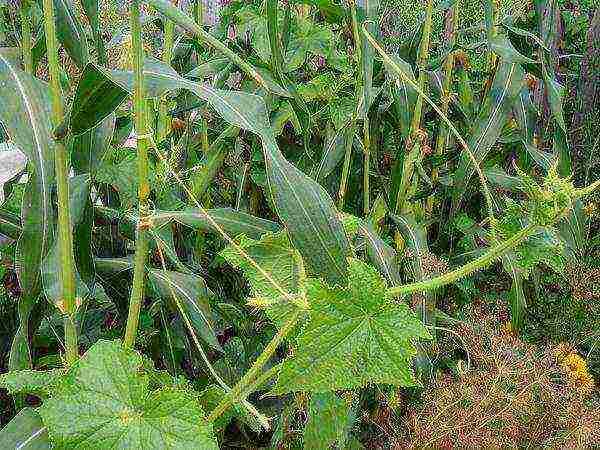 Planting cucumbers with corn frees you from the need to install trellises
Planting cucumbers with corn frees you from the need to install trellises
The developing whips, releasing the antennae, themselves will cling to trunks neighbor, creating a vertical bed. And planted right between the rows of asparagus beans will provide good aeration. This is achieved thanks to a powerful root system that constantly looses the soil.
Joint plantings are also useful because the plants protect each other from pests and diseases (the so-called symbiosis). This excludes the use of drugs with toxic substances. It will be easier for crops to survive in a drought, the soil retains moisture longer with dense planting.
A decorative border of marigolds will not only decorate the beds, but will also scare off pests.
What to plant and grow with cucumbers
Each plant recommended for the neighborhood affects cucumbers in its own way. Some increase the fruiting period, others improve taste.
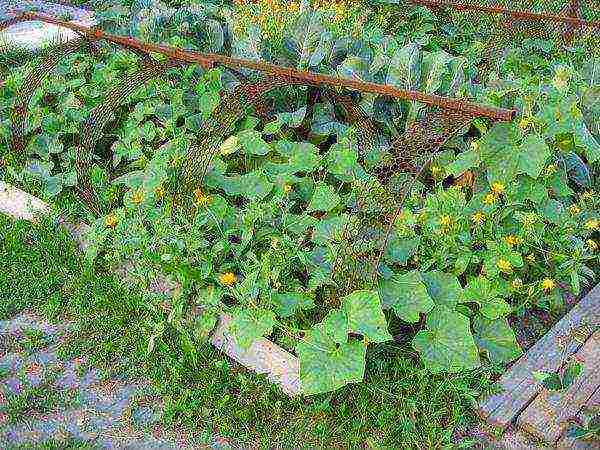 Cucumbers and calendula
Cucumbers and calendula
One of the recommended neighborhood options is to plant a flower calendula... Both plants contribute to the development of each other.
Most often, they are planted near zelentz pepper... In greenhouse conditions, it is necessary to provide for the arrangement of the beds in such a way that daylight is enough for all crops. Vertical trellises can be planted around the perimeter with pepper or eggplant.
It should be remembered that bitter and sweet peppers should not be near, when pollinated, bitterness can pass to neighbors.
Legumes go well with cucumbers. This tandem allows you to increase the yield of greenery. And there will be no lack of moisture in the soil. Recommended vegetables include beans, peas, asparagus.
No less useful for development and fruiting are: Chinese cabbage, spinach, celery... This neighborhood allows you to get greens with high taste.
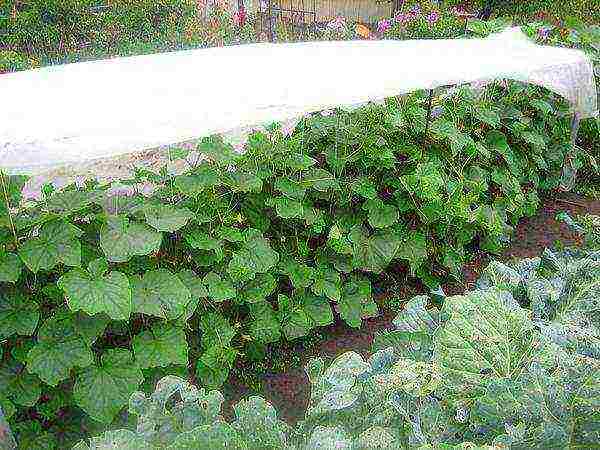 Cucumbers and Chinese cabbage - good for fruiting
Cucumbers and Chinese cabbage - good for fruiting
In regions with a harsh climate, it is possible to grow melons and gourds only in greenhouse conditions. When organizing vertical beds, you can combine the cultivation of cucumbers with watermelons and melons. It is important only when airing to ensure that there are no drafts so that the dessert fruits do not die.
Tomatoes - the pros and cons of co-cultivation
About the close planting of tomatoes and cucumbers, the opinions of gardeners differ. Some believe that differences in growing conditions prevent two crops from getting along in one greenhouse... Others are sure that with the correct organization of the beds, such a combination quite acceptable and they can be placed together.
Tomatoes love a moderately humid environment, in contrast to greenery, which requires it in the soil and air.
It is quite simple to solve the issue - the beds after planting the seedlings need mulch... Mulch prevents overdrying of the soil and the formation of evaporation.
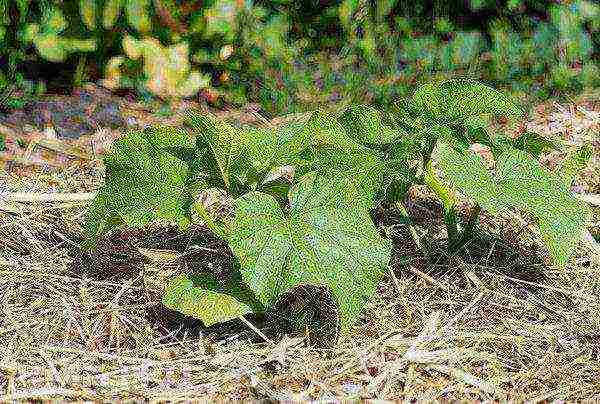 Mulching seedlings after planting
Mulching seedlings after planting
Most of the water used for irrigation goes into the ground or is converted to steam, creating favorable conditions for the development of rot in a polycarbonate greenhouse or greenhouse. In this case, it is rational to monitor the humidity level using vents and doors. Airing refers to preventive measures against fungal infections.
Another way to prevent the formation of fumes is to use hydrogel... A handful of soaked polymer is placed in each well before planting seedlings. Water can be replaced with a solution of mineral fertilizers, then the procedure will be complex.
The use of a hydrogel reduces the intensity of irrigation, making the irrigation process more productive. When decomposed, the material breaks down into water and carbon dioxide, which will only benefit the soil.
Pros from the neighborhood of tomatoes and cucumbers:
- saving space, water for watering;
- increasing the functionality of the greenhouse;
- the possibility of using biological methods in the fight against pests and diseases;
- control of the temperature regime and the degree of soil moisture;
- purchase of the same fertilizers for both plants.
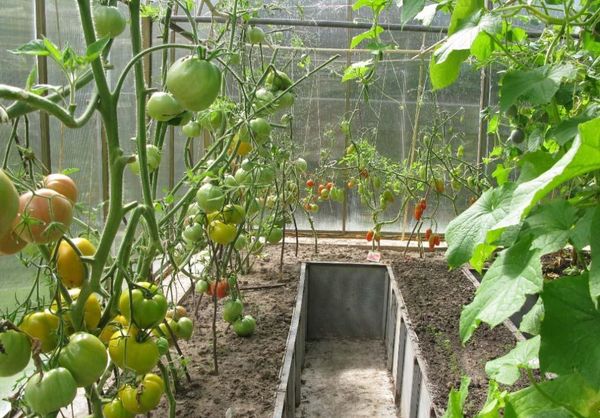 Planting a cucumber with tomatoes saves greenhouse space and water for irrigation
Planting a cucumber with tomatoes saves greenhouse space and water for irrigation
Cons of the neighborhood of cucumbers and tomatoes:
- a high probability of damage to plants by various diseases and pests;
- the need to determine the priority culture;
- equipping the greenhouse with curtains or partitions, the use of special equipment.
Unwanted neighbors for cucumbers
When choosing a neighbor for Zelentsy, one should be guided exclusively by knowledge. Do not plant near cucumber beds aromatic herbs... For the most part, although they scare away insects, they can change the taste of the vegetable.
Onion and garlic pull out the maximum amount of nutrients from the soil, this will slow down the development of the cucumber lash and roots, and lower the yield.
Do not plant near cucumbers and potato... There are several reasons for the negative neighborhood. Firstly, it actively develops a root system, which can damage a weak cucumber root. Secondly, plants have different conditions for planting, watering, fertilizing. The Colorado potato beetle generally poses a great danger to the greens.
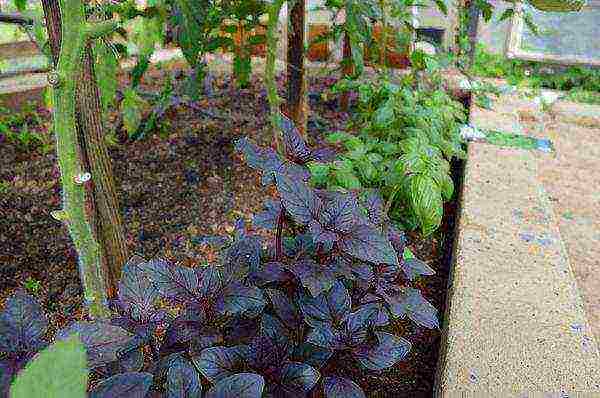 it is not recommended to plant cucumbers next to aromatic herbs
it is not recommended to plant cucumbers next to aromatic herbs
Can harm the yield of cucumbers radish... It also interferes with the development of the root system, reduces the palatability of green fruits.
In addition to the neighborhood, it is important to remember that the landing site should be changed annually. It is rational to return to the old bed no earlier than after 3 years.
Observing the rules of neighborhood in greenhouse beds, favorable conditions are created for the development of both crops. The result is a high yield of vegetables without loss of taste.
The possibilities of most gardeners are significantly limited by the small area of \ u200b \ u200bplots and the presence of only one greenhouse on them, which you want to use to the maximum. Many gardeners are wondering if it is possible to plant tomatoes and cucumbers together in the same greenhouse: how harmful is such a "neighborhood" and will joint cultivation benefit these crops?
Feasibility of joint landing

Experts do not recommend growing tomatoes and cucumbers in the same greenhouse if you want to get a good harvest. It's all about the radically different needs of these crops for illumination, humidity, air quality and watering.
By creating ideal conditions for the growth of the tomato, you will stop the development of cucumbers, and vice versa. So what are the needs of these crops, and how can the atmosphere in the greenhouse be optimized so that they can grow side by side?
Cucumber needs
Cucumbers are very moisture-loving plants that require frequent and abundant watering with warm, settled water, combined with spraying the leaves. The air humidity in the greenhouse should be at least 85% - only then this capricious culture will thank you with a generous harvest.
What else do cucumbers need in a greenhouse? The optimum temperature for the development of plants and the formation of ovaries is from 22 to 28 degrees, they do not like drafts and frequent ventilation. In addition, the crop requires regular nitrogen fertilization.
So, cucumbers need constant dampness and absence of drafts, what do tomatoes need?
Needs of tomatoes
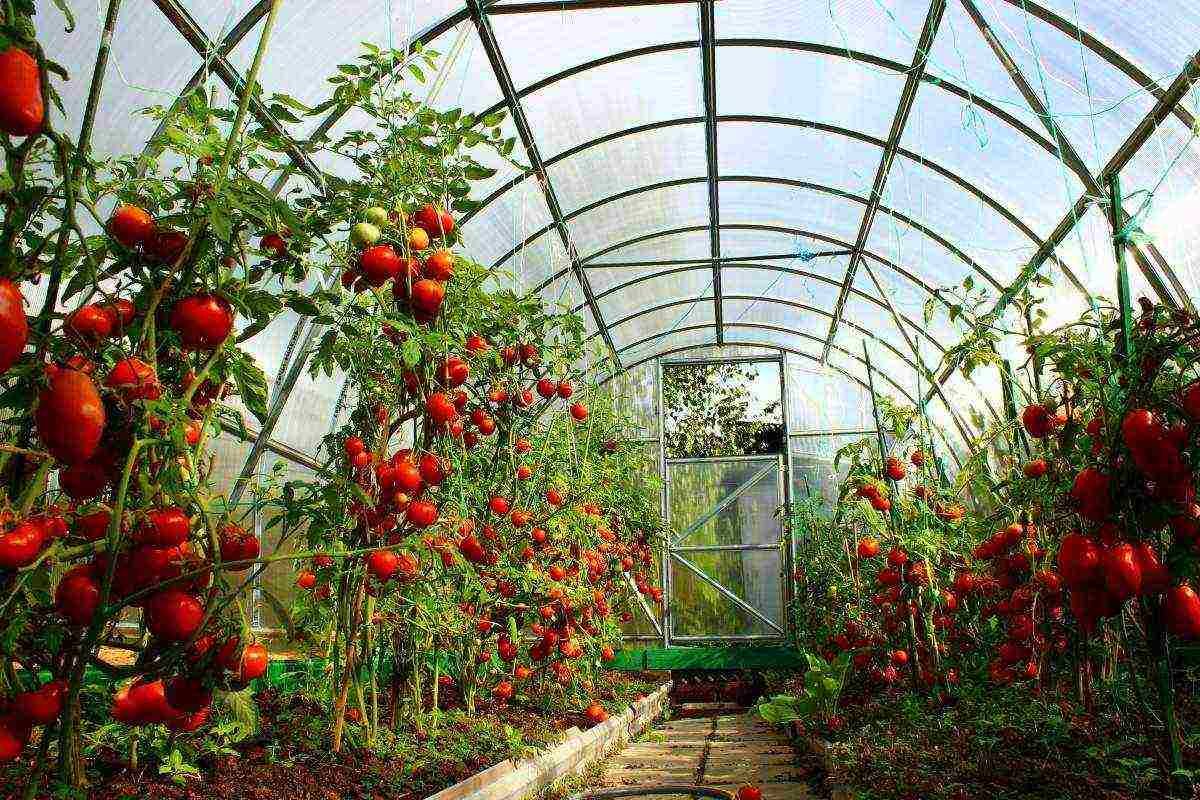
Tomatoes need diametrically opposite conditions: dampness and lack of regular ventilation will lead to the development of late blight, brown spot, gray mold and powdery mildew, which is dangerous for tomatoes.
Tomatoes are rarely watered - once a week is enough - but abundantly, while it is important to supply water to the root so that it goes directly into the ground and does not evaporate into the air. Tomatoes do not like heat - at temperatures above 25 degrees, they noticeably slow down fruiting, which is why the greenhouse needs to be left open during the day and drafts should be arranged with the help of vents at the other end of the greenhouse.
Tomatoes do not need nitrogen fertilizers; for their normal development, other feeding is required - with the content of potassium and phosphorus.
Planting tomatoes and cucumbers in the same greenhouse leads to a rather problematic situation: trying to satisfy the needs of both crops, you thereby destroy them or reduce yields. Dampness and high humidity in the greenhouse lead to a decrease in the immunity of tomatoes and an arrest of their growth. In such conditions, tomatoes are almost always affected by late blight. In addition, the pollen becomes wet, the inflorescences are not pollinated, which means that new ovaries will not appear.
If you strive to create favorable conditions for tomatoes, this will lead to a decrease in the yield of cucumbers. Dry air, lack of constant watering, frequent ventilation and drafts cause not only a slowdown in the growth of lashes, but can also completely ruin the plant.
How to find a compromise if there is no way to plant tomatoes and cucumbers in different greenhouses? It is still possible to grow these crops together, and there are several ways to do this.
Selection of varieties for combined plantings

To successfully grow tomatoes and cucumbers in the same greenhouse, you should carefully choose the seed.
For joint planting, you should select such tomatoes that are resistant to late blight and are not afraid of high humidity:
- "Dubok";
- "Dubrava";
- De Barao Blacks;
- "Dwarf";
- "Lark";
- "Tsar Peter";
- "New Year";
- "Blizzard";
- Soyuz 8;
- "La la fa".
These hybrid varieties bred by agronomists and created have strong immunity and are resistant to late blight and other diseases that tomatoes are exposed to due to high humidity conditions. Of course, the selection of such seeds will not completely eliminate the problems associated with the joint cultivation of different crops, but you will have a chance to preserve all the plants and get a harvest.
In addition to buying tomato seeds protected from late blight, you should also take care of the choice of cool-resistant cucumber varieties. Insufficient air temperature can cause a whole list of specific diseases in this capricious culture - rot, powdery mildew, bacteriosis and anthracosis.
It is dangerous that these diseases can be transmitted to tomatoes, then, trying to create comfortable conditions for tomatoes, you can lose all the plants in the greenhouse and your future harvest.
Agronomists have developed a lot of varieties of cucumbers that are resistant to diseases and suitable for growing in the open field:
- "Benefit";
- "Crane";
- "Princess";
- Leandro;
- "Thumb Boy";
- "Masha";
- "Goosebump";
- "Natalie";
- Pasadena;
- "Diva";
- "Nightingale";
- "Sister Alyonushka".
By choosing such varieties and hybrids of cucumbers that are resistant to cold and diseases, you can not worry about creating a specific microclimate for plants - they can optimally transfer the ventilation of the greenhouse, which is necessary for the normal development and pollination of tomatoes.
How to plant correctly?
For optimal growth and development of neighboring crops, it is important not only to select the seed, but also to plant the plants correctly. The location of cucumbers and tomatoes in the same greenhouse requires taking into account the peculiarities of the microclimate inside the greenhouse.
Separation

Gardeners most often use the crop separation technique when planting cucumbers and tomatoes in the same greenhouse. Their physical delimitation in the greenhouse area helps to avoid overflow of tomatoes and protects the whip from drafts.
As a rule, all greenhouses are installed in a west-east direction.This orientation provides optimal illumination of all crops from the south side.
Depending on the width of the greenhouse, 2-3 longitudinal beds are arranged in it:
- Cucumbers are planted in the northern bed. Here they will not be overdried by the sun, and the water will not evaporate so intensively into the air during irrigation.
- Tomatoes are planted in the central garden bed. There will be fresh air necessary for their comfort and pollination when ventilated.
- In the southern garden it is preferable to grow greens or eggplants. It will be too hot for tomatoes and too dry for cucumbers.
Since the soil in the greenhouse is a single whole, before planting seedlings and seed, you should attend to the demarcation of the soil. Sheets of roofing material or iron are dug in between future beds - such a measure will protect tomatoes from waterlogging with frequent watering of cucumbers and will allow you to apply fertilizers intended for each crop.
Zoning
Zoning is perhaps the most effective and optimal way to organize the space inside the greenhouse when growing different crops. This technique allows you to maintain the microclimate necessary for tomatoes and cucumbers in each part of the greenhouse.
The greenhouse is usually zoned across, dividing it into two functional parts.
There are two ways to make a partition:
- Capital method. A partition is made of cellular polycarbonate inside the greenhouse. The entrance to this compartment can be made both in the created "wall", and on the other side of the greenhouse.
- Fast way. The space inside the greenhouse can be delimited by hanging a curtain made of double-folded dense film on a stretched string or rod.
When zoning the greenhouse space, one must not forget about the separation of the soil: dig a sheet of roofing material, iron or a piece of polycarbonate of a suitable size into the ground at the border of the crops. It is recommended to put a tank with water in the "cucumber compartment" - it will not only serve for irrigation, but also additionally humidify the air in the separated area.
Hydrogel
 When growing tomatoes and cucumbers together, hydrogel becomes a real salvation for many gardeners.
When growing tomatoes and cucumbers together, hydrogel becomes a real salvation for many gardeners.
A modern adsorbent perfectly eliminates the problem of waterlogging of the soil and air - the crystals almost instantly absorb water during irrigation and give it to the roots of moisture-loving plants as needed.
Since water is absorbed by the hydrogel, during watering, there is no intense evaporation of moisture into the air and the humidity in the greenhouse does not increase. Thus, the use of an adsorbent does not reduce the immunity of a tomato, and at the same time provides cucumbers with the necessary liquid - both neighboring crops are comfortable.
When planting cucumber seedlings, it is enough to add about 0.5 cups of ready-made hydrogel to the hole, spill abundantly and then dig in the plant in the swollen granules. Most often, seeds are sown in a greenhouse - in this case, an organized hole with a sorbent is sprinkled with 5 cm of soil, and the prepared material is sown into the ground.
The hydrogel is convenient because it absorbs not only water, but also mineral fertilizers dissolved in it. If you soak the granules in a weak fertilizing solution before the first use, you can not worry about the nutrition of the cucumbers for a long time.
Mulch
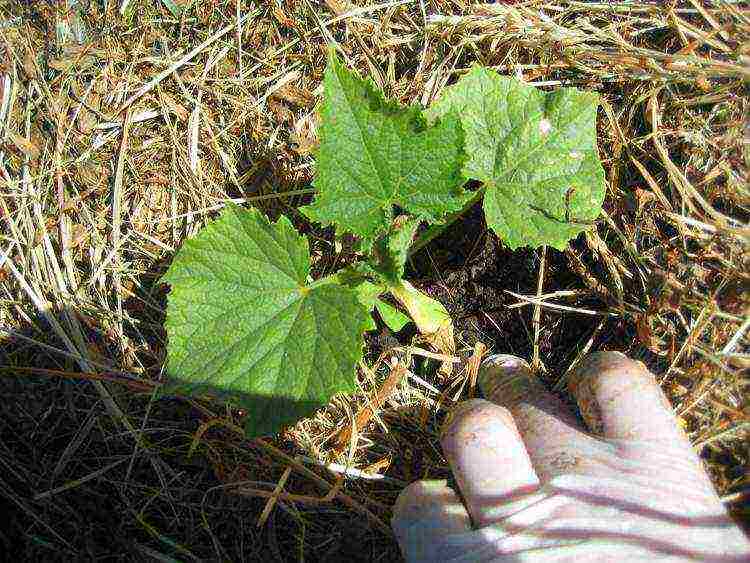
If you have already sown cucumbers in the greenhouse and it was not possible to add the hydrogel to the soil in time, you can use the mulching method. This method also helps to retain moisture at the plant roots and prevents excessive evaporation.
How to use mulch correctly:
- Prepare grass clippings or weeds that have been weeded out.
- When the seedlings sprout and the cucumbers release a real leaf, the soil around them is covered with a thick (8-10 cm) layer of mulch.
- As the layer subsides, it should be raised to the previous level of 10 cm.
Mulching allows you to reduce the number of water-loving plants, in addition, the gradually decaying lower layer releases heat, which cucumbers love so much, and nutritious organic fertilizers that are important for the development of any crop. Moisture from the soil will evaporate not into the air of the greenhouse, but under a dense mulch, creating a comfortable microclimate under each plant.
Growing cucumbers and tomatoes together in a greenhouse is undesirable, but still possible. The main thing is to divide the cultures and create for each of them the most comfortable conditions for development and fruiting.
